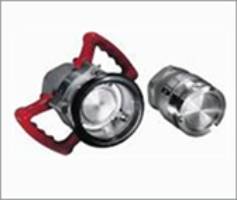In industrial settings, excessive noise and vibration are not merely nuisances but serious concerns that affect the longevity of the equipment, operational efficiency, and workplace safety. These issues often stem from the connection points between rotating equipment such as motors, pumps, and other machinery. The humble coupling—a mechanical device connecting two shafts—plays a surprisingly significant role in managing these problems. When properly selected and installed, couplings serve as the unsung heroes of industrial machinery, significantly reducing harmful vibrations and noise that can wreak havoc on your operations.
Looking to buy camlock coupling for your industrial application? The selection process requires careful consideration of vibration dampening properties. Camlock couplings offer excellent vibration isolation characteristics when matched to the specific application needs. Their secure locking mechanism prevents additional vibration from developing due to loose connections. When selecting couplings for noise reduction purposes, remember that material composition matters tremendously—elastomeric inserts in couplings can absorb vibrations before they translate into noise, while metal-to-metal contact typically amplifies both issues.
If you’re considering options to buy todo coupling solutions, you’ll find they excel in vibration reduction through their flexible design elements. Todo couplings incorporate features specifically engineered to manage torsional vibration—the twisting forces that occur during operation and cause significant noise generation. The design allows for slight misalignment without creating additional stress on connected equipment. Many industrial engineers report substantial improvements in noise levels after upgrading to properly sized todo couplings, especially in applications with variable speeds or loads.
How Couplings Reduce Machinery Vibration
The primary mechanisms through which couplings reduce vibration include misalignment compensation and damping capacity. Even the most precisely aligned machinery experiences some degree of misalignment during operation due to thermal expansion, foundation settlement, or dynamic loading. Quality couplings accommodate these misalignments while preventing the transfer of destructive forces between connected equipment. Without this compensation, misalignments create vibration patterns that worsen over time, damaging bearings and seals.
Torsional vibration—a particularly troublesome form of vibration in rotating equipment—occurs when power delivery fluctuates during rotation. This phenomenon is common in reciprocating engines, compressors, and certain types of pumps. Flexible couplings with carefully engineered elastomeric or spring elements can absorb these torsional shocks before they propagate through the drivetrain. This absorption capability not only protects connected equipment but also significantly reduces the noise generated by these vibrational forces.
Noise Reduction Benefits of Proper Coupling Selection
Machinery noise often directly results from vibration—the higher the vibration, the greater the noise production. By addressing vibration at its source, coupling solutions simultaneously tackle noise problems. The relationship between vibration frequency and noise generation follows clear physical principles: when vibration forces cause machine surfaces to oscillate, they create pressure waves in the surrounding air—what we perceive as sound. By interrupting this transfer path, couplings serve as acoustic insulators in addition to their mechanical functions.
Materials used in coupling construction significantly influence their noise reduction capabilities. Industrial fluid transfer systems particularly benefit from couplings that incorporate noise-dampening materials. Rubber, polyurethane, and special composite elements embedded within coupling designs can dissipate vibrational energy as heat rather than allowing it to convert to acoustic energy. Some advanced coupling designs incorporate multiple stages of vibration isolation to address different frequency ranges, providing comprehensive noise reduction across the operational spectrum.
Coupling Technologies for Different Vibration Challenges
Different industrial applications present unique vibration profiles requiring specific coupling solutions. High-speed applications typically generate high-frequency vibrations that demand couplings with excellent damping characteristics at those frequencies. Conversely, heavy-duty, low-speed applications often produce problematic low-frequency vibrations that require couplings with different performance attributes. Understanding the specific vibration signature of your application helps select the most effective coupling solution.
Modern quick-release couplings often incorporate advanced vibration control features while maintaining their primary function of allowing rapid connection and disconnection. This dual functionality proves particularly valuable in testing environments or applications requiring frequent equipment changes. Engineers should evaluate the entire system’s vibration characteristics rather than viewing machinery components in isolation. A coupling that performs admirably in one application might exacerbate vibration problems in another due to resonance issues or improper impedance matching between connected equipment.
Maintenance Considerations for Optimal Vibration Control
Even the most advanced coupling will fail to perform its vibration-dampening function without proper maintenance. Regular inspection of wear components—particularly elastomeric elements that naturally degrade over time—ensures consistent performance. Degraded coupling elements often exhibit increased clearance, misalignment, or visible wear patterns that compromise their vibration control capabilities. Establishing a regular maintenance schedule specifically addressing coupling conditions helps maintain noise and vibration control throughout the system’s operational life.
Installation quality dramatically affects a coupling’s ability to reduce vibration and noise. Improper mounting, insufficient torque on fasteners, or improper alignment during installation can create new vibration sources rather than eliminating existing ones. Durable industrial hoses connected to equipment often transmit vibrations from their source to other system components. Using appropriate couplings at these connection points prevents vibration transfer through fluid-carrying components, addressing a commonly overlooked vibration path in industrial systems.
Selecting the right coupling represents one of the most cost-effective approaches to reducing machinery vibration and noise in industrial settings. The relatively small investment in quality couplings pays dividends through extended equipment life, reduced maintenance costs, and improved workplace conditions. When evaluating your system’s vibration and noise concerns, consider consulting with coupling specialists who can recommend specific solutions tailored to your application requirements. Take action today by assessing your current coupling installations—this simple step might be the key to quieter, smoother operations and happier equipment operators.
